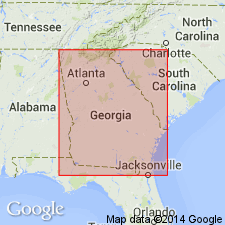
- Usage in publication:
-
- Nakomis Formation
- Modifications:
-
- Named
- Dominant lithology:
-
- Sand
- Clay
- AAPG geologic province:
-
- South Georgia sedimentary province
Summary:
Name Nakomis Formation is proposed here for variably bedded sands with gray, thinly bedded clay (smectite?), and massive, white to carbonaceous kaolin deposits that form the base of the Fort Valley Group (new). The Fort Valley includes all of the kaolinitic, sandy deposits in the Fort Valley plateau region of central GA that are of coastal marine origin, while the correlative Oconee Group (new) includes those of fluvial origin. In addition to the type locality in the bluffs along the Flint River, two reference localities are designated. The Georgia Geologic Survey cores Crawford 2a and 2b (GGS-3600) taken along the north shoulder of GA Hwy 96, 1.9 mi east of Nakomis serve as the upper boundary stratotype. Here the Nakomis occurs between 105 ft and 231 ft and disconformably underlies the Marshallville Formation. The Georgia Geologic Survey core Crawford 1b (GGS-3698) taken along the shoulder of a county hwy at Zenith, Crawford Co., serves as the lower boundary stratotype. The Nakomis occupies the interval from 127 ft to 231 ft and disconformably overlies the Gaillard Formation of the Oconee Group. Unit occurs in a narrow band in the shallow subsurface from eastern Taylor Co. in the west, to the Ocmulgee River. Crops out near Reynolds, GA. East of the Ocmulgee River, unit intertongues with the Ripley Formation. Age of the Nakomis is projected to be Late Cretaceous (early Navarroan, early Maastrichtian) based on the physical correlation with the Ripley to the south.
Source: GNU records (USGS DDS-6; Reston GNULEX).
For more information, please contact Nancy Stamm, Geologic Names Committee Secretary.
Asterisk (*) indicates published by U.S. Geological Survey authors.
"No current usage" (†) implies that a name has been abandoned or has fallen into disuse. Former usage and, if known, replacement name given in parentheses ( ).
Slash (/) indicates name conflicts with nomenclatural guidelines (CSN, 1933; ACSN, 1961, 1970; NACSN, 1983, 2005, 2021). May be explained within brackets ([ ]).

